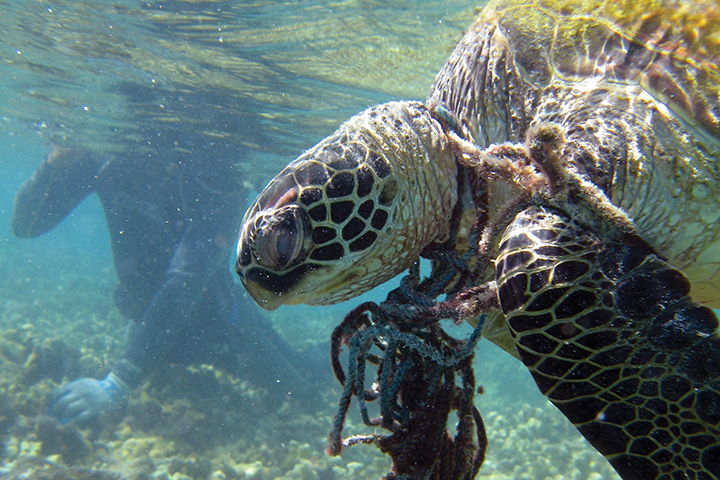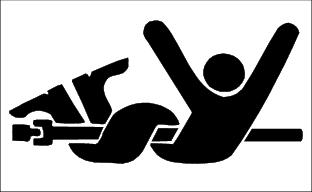To recall, sea-birds confuse
small bits of plastic with food. They swallow the bits of plastic and
it kills them. [a] To recall, abandoned fishing gear entangles fish,
turtles and marine mammals, and its kills them. Floating plastic
bags do the same. And so on, but that is not the end of the story
[1].
 |
| The NOAA Marine Debris Program funds projects to remove derelict fishing nets and other debris from marine waters, where they can entangle marine life. (NOAA) |
Each
year some
6.4 million tonnes of litter are entering the oceans, or about one
kilogram for each human being. Most litter stems from cities. “The
world's cities currently generate around 1.3 billion tonnes of
municipal solid waste a year, or 1.2 kilogram per city-dweller per
day.” [b Thus, the litter discharged into the sea corresponds to
about 4-5% of the municipal solid waste produced in the cities of the
world. In that sense its a small part of waste produced by the nine
billion humans, but as any dumping it causes problems.
More
generally, marine
litter is defined as ‘‘any persistent, manufactured or processed
solid material discarded, disposed of or abandoned in the marine and
coastal environment." Persistent littering the sea likely has
started with disposing “clinker” from steamships and currently
has found its peak with “plastic”.
Clinker,
the residue of burnt coal, was commonly dumped from steamships well
into the 20th century. In the Mediterranean Sea, its occurrence on
the deep sea-floor has been shown to coincide with such shipping
routes.
Currently,
the most abundant marine litter is plastic. Only part of the plastic
items float at the sea surface or close to it. Two third of the
plastic sinks to the bottom of the sea when converted by fouling
organisms. Therefore plastic accumulation on the seabed is more
abundant than in the open sea. Thus, below the floating garbage is an
even bigger garbage dump at the sea bottom.
Litter
is present in all marine habitats, from beaches to the most remote
points in the oceans, such as the Midway Islands in the Pacific [a.
The
particular distribution
and accumulation of litter in the ocean is influenced by water
movements, bottom morphology and economic activities.
On
the global scale, the ocean currents sweep the litter to the centre
of the ocean-gyres where it accumulates, called the big garbage
patch. On the local scale, litter is washed upon the beach. On the
hidden scale, litters is channelled to the deep sea. Marine litters
accumulates in particular high densities in submarine canyons.
 |
| from: http://www.classroomatsea.net/ portugal/tobi_cruise/index.html (from coast down to > 4000m depth) |
Submarine
canyons act as passages for litter transport from continental shelves
into deeper waters. Submarine canyons are areas where organic debris
accumulates. The debris is food for bottom-dwelling fauna and
suspension-feeding invertebrates. They are abundant in submarine
canyons. The accumulation of plastics in submarine canyons likely has
a detrimental effects on theses deep-sea organisms.
A survey [2] of European seas published in April 2014, confirmed again that marine litter is found everywhere, from the beach down to the deep sea. The survey uses standardized methods to categorize the litter and to quantify its abundance. Most common litter items included, non-surprisingly, plastic bags, glass bottles and abandoned fishing lines and nets:
- Plastic represented 41% of the litter items in European seas, whilst abandoned fishing gear accounted for 34% of the total. Clinker, glass and metal are least common. Density and composition of litter in European seas is comparable to what has found in other parts of the world ocean.
- Litter density in submarine canyons reached an average of 12.2 – 6,4 items per ten-thousand square meters, or the double of the litter density found elsewhere.
A litter density of 12.2 – 6,4 items per ten-thousand square meters means to find about 10 items of
litter on a surface wide as a football field!
A list of locations
with highest litter densities in European waters includes for
example the Lisbon Canyon in continental shelf of Portugal or the
Blanes Canyon in the continental shelf of the Mediterranean sea of
Spain. Theses canyons were formed when the sea-level was much lower
than today.
Litter is a serious risk for
the marine environment. Entanglement in abandoned fishing gear is a
serious threat for birds, turtles and marine mammals, it is also
causing high mortality of fish through ‘‘ghost fishing''. Beyond
other threats, plastic is a source of toxic chemicals that is lethal
to marine fauna.
 |
| from: http://manuals.deere.com/ |
The degradation of plastics
generates micro-plastics that are ingested by organisms, leading to
contaminants across trophic levels up to the fish [3] that we may
eat. So plastic debris may return to their source, finally.
Martin.Mundusmaris@gmail.com
info@mundusmaris.org
[1]
José G.B. Derraik, 2002, The pollution of the marine environment by
plastic debris, Marine Pollution Bulletin 44(9), pp. 842-852.
[2]
Christopher K. Pham et. Al, 2014.
Marine Litter Distribution and Density in European Seas, from the
Shelves to Deep Basins.
PLOS ONE, 9(4), pp. 1-13.
[3]
Chelsea
M. Rochman et al. 2013, Ingested
plastic transfers hazardous chemicals to fish and induces hepatic
stress, Nature, doi:10.1038/srep03263;
[a]
http://www.youtube.com/watch?feature=player_detailpage&v=7xCOh_UCLJg,
[b]
Economist, 7th June 2012, http://www.economist.com/blogs/graphicdetail/2012/06/daily-chart-3
[c]
http://5gyres.org/posts/2013/12/09/do_toxic_chemicals_absorbed_by_plastic_transfer_to_fish_after_ingestion_yes/
No comments:
Post a Comment